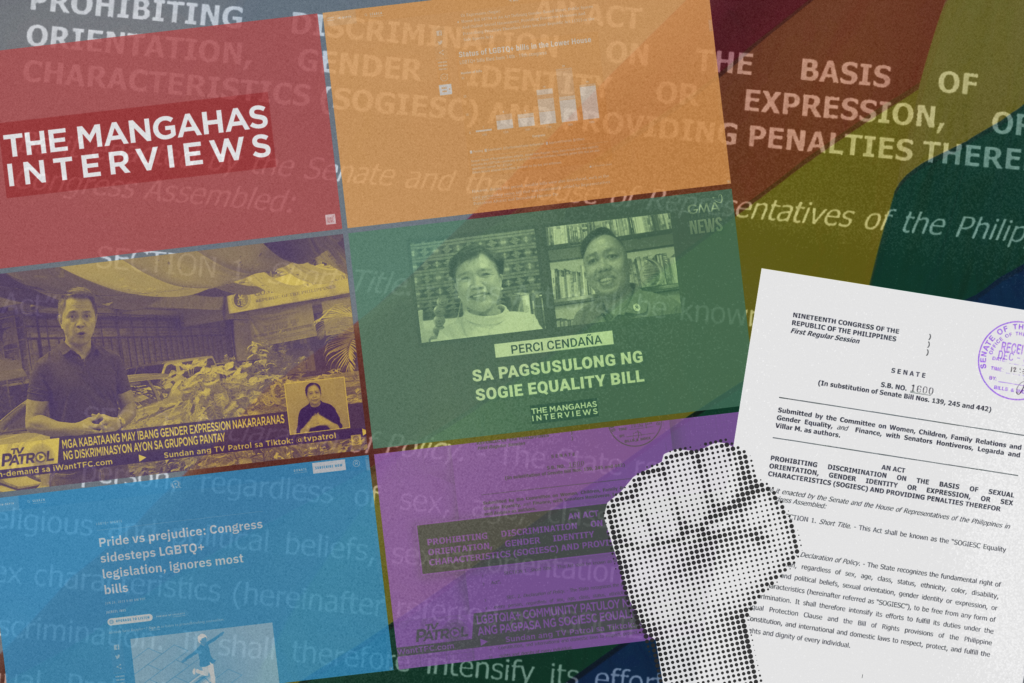Pride Month: Impressive media focus on SOGIESC Equality bill

CHEERS TO some media for marking LGBTQ+ Pride Month with critical and informative coverage. These news organizations kept the LGBTQ+ community and its rights on the agenda, with reports on the SOGIESC Equality Bill and the future of LGBTQ+ rights in the Philippines.
What’s the Story?
A common thread among most reports on LGBTQ+ issues in the country is the SOGIESC (Sexual Orientation, Gender Identity, Gender Expression, or Sex Characteristics) Equality Bill. LGBTQ+ Filipinos and their allies have called for the passage of the landmark measure, which has languished in Congress for decades. This is reflected in the media’s coverage that show the efforts made to elevate the voices and concerns of the LGBTQ+ community.
ABS-CBN News’ June 23 TV Patrol report by Adrian Ayalin presented the ongoing campaign for the passage of the SOGIESC Equality Bill as told by LGBTQ+ Filipinos, rights advocates, government officials, and religious groups. The easy to follow yet comprehensive report aired on the network’s primetime newscast, maximizing the reach of its message.
Rappler’s June 24 in-depth report by Jezreel Ines tracked the progress of the SOGIESC Equality Bill and its previous versions, from the 14th Congress to the 19th Congress. The report also mapped local-level ordinances protecting LGBTQ+ Filipinos from discrimination at provincial, city, and municipal levels around the country. Interviews with LGBTQ+ Filipinos who had experienced the type of discrimination that the SOGIESC Equality Bill seeks to prevent enriched the research-driven report. Ines also sought insight from Geraldine Roman, Bataan’s representative in Congress and chairperson of the House Committee on Women and Gender Equality, on the “delaying tactics” used in the House against the bill. Jap Ignacio, secretary-general of Lagablab LGBT Network, discussed the future of pro-LGBTQ+ legislation in the country.
GMA Integrated News’ June 24 episode of the Mangahas Interviews likewise discussed the SOGIESC Equality Bill and the overall rights situation of LGBTQ+ Filipinos. Host Malou Mangahas interviewed activist Perci Cendaña, president of Babaylanes, an LGBTQ+ advocacy organization. The episode showed that having a knowledgeable guest and using approachable language makes for effective and interesting conversations on otherwise technical or unrelatable topics. In the nearly 40-minute-long video, the two also touched on other gender equality-related measures on hate crimes, gender recognition, and marriage equality.
What the Media Got Right
While the reports above did a good job, ABS-CBN stood out for making the extra effort to put up a dedicated microsite for Pride Month stories. It also showed consistency, since ABS-CBN News covered in an online report the first protest launched by advocacy groups to kick off Pride Month on June 2. Few other media picked up the event. Rather than let coverage die down after covering the major culminating events of the month, such as the historic Pride Festival in Quezon City attended by over 100 thousand, ABS-CBN went on to finish the month with an in-depth report on gender-affirming healthcare and an engaging video on the Quezon City government’s Right to Care Card.
Overall, media did well in centering LGBTQ+ perspectives by seeking out LGBTQ+ sources and experts for their reports. Rather than being treated as mere subjects of news, LGBTQ+ Filipinos were given the space and platform to self-advocate and reach wider audiences.
Why Is this Important?
As Cendaña noted in his interview, LGBTQ+ Filipinos are at a point of “high public visibility” in society. While this may, in some cases, translate into open hostility against people with diverse SOGIESC, this increased visibility can be good for LGBTQ+ people.
As the Pride Month media coverage shows, it takes sensitivity and involvement from stakeholders to elevate the discourse and improve the depiction of LGBTQ+ Filipinos and their diversity. Thankfully, there are ways to sustain this. Bahaghari Center’s Media Reference Guide on LGBT terminology in the Philippines, the Association of LGBTQ Journalists’ terminology stylebook, and the GLAAD Media Reference Guide are references and resources that journalists can use.
The news media can be the allies of LGBTQ+ Filipinos in helping to increase not just the visibility of their cause but in empowering them as they struggle for equal rights.
Leave a Reply